Related Research Articles

Transport economics is a branch of economics founded in 1959 by American economist John R. Meyer that deals with the allocation of resources within the transport sector. It has strong links to civil engineering. Transport economics differs from some other branches of economics in that the assumption of a spaceless, instantaneous economy does not hold. People and goods flow over networks at certain speeds. Demands peak. Advance ticket purchase is often induced by lower fares. The networks themselves may or may not be competitive. A single trip may require the bundling of services provided by several firms, agencies and modes.

A toll road, also known as a turnpike or tollway, is a public or private road for which a fee is assessed for passage. It is a form of road pricing typically implemented to help recoup the costs of road construction and maintenance.

The London congestion charge is a fee charged on most cars and motor vehicles being driven within the Congestion Charge Zone (CCZ) in Central London between 7:00 am and 6:00 pm Monday to Friday, and between 12:00 noon and 6:00 pm Saturday and Sunday.
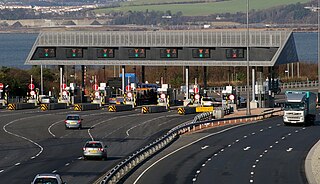
Road pricing are direct charges levied for the use of roads, including road tolls, distance or time-based fees, congestion charges and charges designed to discourage the use of certain classes of vehicle, fuel sources or more polluting vehicles. These charges may be used primarily for revenue generation, usually for road infrastructure financing, or as a transportation demand management tool to reduce peak hour travel and the associated traffic congestion or other social and environmental negative externalities associated with road travel such as air pollution, greenhouse gas emissions, visual intrusion, noise pollution and road traffic collisions.

Congestion pricing or congestion charges is a system of surcharging users of public goods that are subject to congestion through excess demand, such as through higher peak charges for use of bus services, electricity, metros, railways, telephones, and road pricing to reduce traffic congestion; airlines and shipping companies may be charged higher fees for slots at airports and through canals at busy times. Advocates claim this pricing strategy regulates demand, making it possible to manage congestion without increasing supply.

Traffic congestion is a condition in transport that is characterized by slower speeds, longer trip times, and increased vehicular queueing. Traffic congestion on urban road networks has increased substantially since the 1950s. When traffic demand is great enough that the interaction between vehicles slows the traffic stream, this results in congestion. While congestion is a possibility for any mode of transportation, this article will focus on automobile congestion on public roads.

The Singapore Area Licensing Scheme (ALS), was a road pricing scheme introduced in 1975 to 1998, charged drivers who were entering downtown Singapore, and thereby aimed to manage traffic demand. This was the first urban traffic congestion pricing scheme to be successfully implemented in the world. This scheme affected all roads entering a 6-square-kilometre area in the Central Business District (CBD) called the "Restricted Zone" (RZ), later increased to 7.25 square kilometres to include areas that later became commercial in nature. The scheme was replaced in 1998 by the Electronic Road Pricing.
Trondheim Toll Scheme or Trondheim Package was the result of that in the 1980s politicians and road authorities in Trondheim, Norway wanted to accelerate the investments in roads and motorways around the city through an investment package and toll scheme to ease construction and generate more funds. Between 1991 and 2005, there were more than 20 toll plazas throughout the city that help finance the new roads. Toll plazas will still remain east of the city at least until 2012. The toll collection is administrated by Trøndelag Veifinans.

Electronic toll collection (ETC) is a wireless system to automatically collect the usage fee or toll charged to vehicles using toll roads, HOV lanes, toll bridges, and toll tunnels. It is a faster alternative which is replacing toll booths, where vehicles must stop and the driver manually pays the toll with cash or a card. In most systems, vehicles using the system are equipped with an automated radio transponder device. When the vehicle passes a roadside toll reader device, a radio signal from the reader triggers the transponder, which transmits back an identifying number which registers the vehicle's use of the road, and an electronic payment system charges the user the toll.
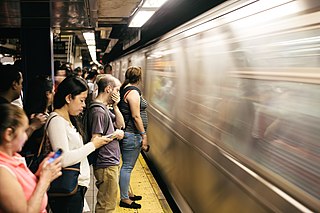
A rush hour or peak hour is a part of the day during which traffic congestion on roads and crowding on public transport is at its highest. Normally, this happens twice every weekday: once in the morning and once in the afternoon or evening, the times during which the most people commute. The term is often used for a period of peak congestion that may last for more than one hour.

The Electronic Road Pricing (ERP) system is an electronic toll collection scheme adopted in Singapore to manage traffic by way of road pricing, and as a usage-based taxation mechanism to complement the purchase-based Certificate of Entitlement system.

The Edinburgh congestion charge was a proposed scheme of congestion pricing for Scotland's capital city. It planned to reduce congestion by introducing a daily charge to enter a cordon within the inner city, with the money raised directed to fund improvements in public transport. The scheme was the subject of intense public and political debate and ultimately rejected. A referendum was held and nearly three-quarters of respondents rejected the proposals.
Smeed's Law is an empirical rule suggested to relate traffic fatalities to traffic congestion as measured by the proxy of motor vehicle registrations and country population. The law proposes that increasing traffic volume leads to an increase in fatalities per capita, but a decrease in fatalities per vehicle.

Motoring taxation in the United Kingdom consists primarily of vehicle excise duty, which is levied on vehicles registered in the UK, and hydrocarbon oil duty, which is levied on the fuel used by motor vehicles. VED and fuel tax raised approximately £32 billion in 2009, a further £4 billion was raised from the value added tax on fuel purchases. Motoring-related taxes for fiscal year 2011/12, including fuel duties and VED, are estimated that will amount to more than £38 billion, representing almost 7% of total UK taxation.
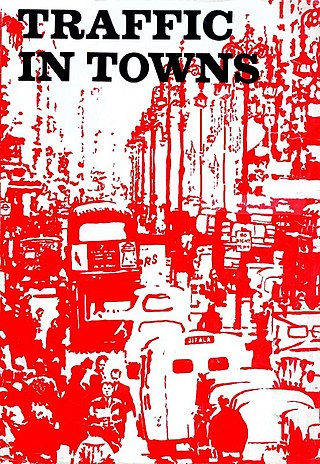
Traffic in Towns was an influential report and popular book on urban and transport planning policy published 25 November 1963 for the UK Ministry of Transport by a team headed by the architect, civil engineer and planner Colin Buchanan. The report warned of the potential damage caused by the motor car, while offering ways to mitigate it. It gave planners a set of policy blueprints to deal with its effects on the urban environment, including traffic containment and segregation, which could be balanced against urban redevelopment, new corridor and distribution roads and precincts.
Reuben Jacob Smeed CBE (1909–1976) was a British statistician and transport researcher. He proposed Smeed's law which correlated traffic fatalities to traffic density and predicted that the average speed of traffic in central London would always be nine miles per hour without other disincentives, given that this was the minimum speed that people will tolerate.
The Ecopass program was a traffic pollution charge implemented in Milan, Italy, as an urban toll for some motorists traveling within a designated traffic restricted zone or ZTL, corresponding to the central Cerchia dei Bastioni area and encircling around 8.2 km2 (3.2 sq mi). The Ecopass was implemented as a one-year trial program on January 2, 2008, and later extended until December 31, 2009. A public consultation was planned to be conducted early in 2009 to decide if the charge becomes permanent. Subsequently, the current charge-scheme was prolonged until December 31, 2011 and starting from January 16, 2012 a new scheme was introduced, actually converting it from a pollution-charge to a conventional congestion charge.
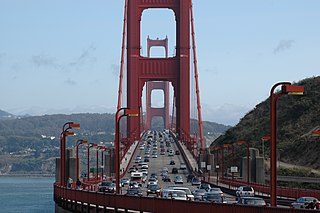
San Francisco congestion pricing is a proposed traffic congestion user fee for vehicles traveling into the most congested areas of the city of San Francisco at certain periods of peak demand. The charge would be combined with other traffic reduction projects. The proposed congestion pricing charge is part of a mobility and pricing study being carried out by the San Francisco County Transportation Authority (SFCTA) to reduce congestion at and near central locations and to reduce its associated environmental impacts, including cutting greenhouse gas emissions. The funds raised through the charge will be used for public transit improvement projects, and for pedestrian and bike infrastructure and enhancements.

Road pricing in the United Kingdom used to be limited to conventional tolls in some bridges, tunnels and also for some major roads during the period of the Turnpike trusts. The term road pricing itself only came into common use however with publication of the Smeed Report in 1964 which considered how to implement congestion charging in urban areas as a transport demand management method to reduce traffic congestion.
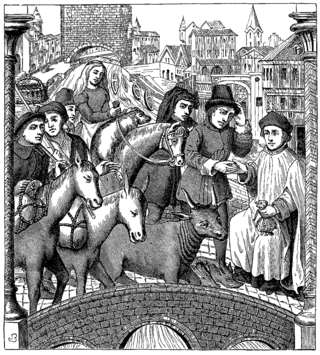
A toll is a fee charged for the use of a road or waterway.
References
- ↑ Smeed, R.J. (1964). Road pricing: the economic and technical possibilities. HMSO.
- ↑ Dyson, Freeman (4 November 2006). "A Failure of Intelligence". MIT Technology Review. Retrieved 25 November 2007.
- ↑ "Michael Thomson obituary". The Guardian . 13 July 2010. Archived from the original on 16 January 2022.
- 1 2 Goodwin, P B (23 October 1997). "Solving Congestion (when we must not build roads, increase spending, lose votes, damage the economy or harm the environment, and will never find equilibrium)" (PDF). University College London. Archived from the original (PDF) on 26 July 2021.
- ↑ "Experts' plan to cut traffic pressure". The Times. 11 June 1964.
- ↑ "Mrs. Castle Learns From U.S. Mistakes". The Times. 17 October 1966.
- ↑ "'Frustration' over road pricing". The Times. 3 July 1967.
- ↑ "Options in Transport Tariff Policy". EEC, Brussels. 1967.
- ↑ John Hibbs and Gabriel Roth (1992). "Tomorrow's Way – Managing roads in free society". The Adam Smith Institute.
- ↑ "Road Charging Scheme: Asia – Singapore". UK Commission for Integrated Transport. 21 June 2006. Archived from the original on 26 November 2007. Retrieved 26 November 2007.
- ↑ "Fjellinjen A/S, Oslo toll operator" . Retrieved 26 November 2007.
- ↑ "Road Charging Scheme: Europe – Norway, Oslo". UK Commission for Integrated Transport. 21 June 2006. Archived from the original on 20 November 2007. Retrieved 25 November 2007.
- ↑ "Toll road lawyers in award hope". BBC News. 9 April 2006. Retrieved 23 November 2007.
- ↑ "Smooth start for congestion charge". BBC News. 18 February 2003. Retrieved 26 May 2007.
- ↑ "The real cost of road pricing". BBC News. 7 June 2005. Retrieved 25 November 2007.